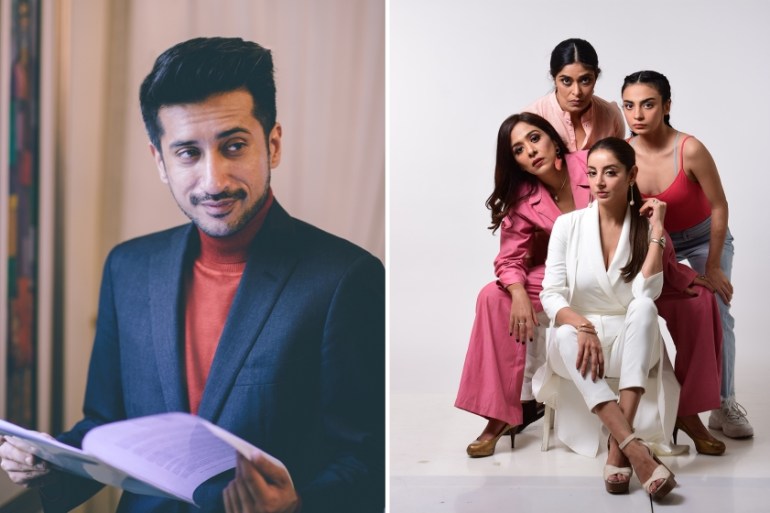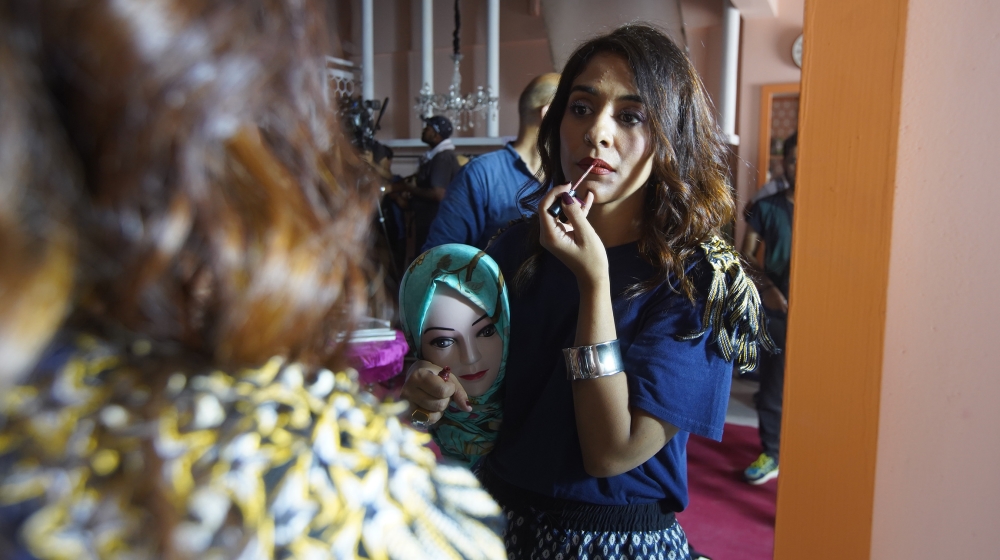
In TV show ‘Churails’, Pakistani women take on society’s demons
Churails has been lauded for breaking new ground, smashing stereotypes and putting women at the centre of its story.
by Asad HashimIslamabad, Pakistan – Ten women, dressed in colourful burqas and armed with hockey sticks, cricket bats and their wits, step out of a shop to confront an angry mob.
Over two minutes, they deliver a sound beating to a mainly male group that had gathered at the door, having shown up thinking they could stop the women from doing what they do best, helping other women out of difficult or violent situations.
Using cricket bats, hockey sticks and even whiskey they found lying around, the women push the shocked mob back.
Churails is certainly not your everyday Pakistani television show.
This cathartic scene in particular flies in the face of how such confrontations are generally expected to go in Pakistan, a country of 207 million people where violence against women is frequent and widespread.
Written and produced in Pakistan, Churails – which was released in August on Indian streaming platform Zee5 – breaks new ground, smashing stereotypes and putting strong women at the centre of its story.
It follows the stories of four women – a rich homemaker, a wedding planner, a recently released convict and a boxer – in the southern Pakistani city of Karachi, as they fight the patriarchy and set up a detective service to help other women in need.
Lauded for breaking the mould of formulaically written female characters in South Asian television, the show has raised concerns from Pakistani feminists about how it treats issues of class and homosexuality, and whether it is commodifying feminism.
The “churails”, so named after an Urdu word for “witches”, spend 10 episodes investigating cheating husbands, confronting abusive partners, browbeating a landlord and ultimately uncovering a massive conspiracy to traffick and murder women.
It is a wild ride, and the characters often curse, bludgeon and drink their way through it.
For the critics, the show is a complex one to break down, and much of their concern stems from one question: Is the show capitalising on feminism, delivering a feel-good ride without actively confronting the structures of violence in South Asian society?
‘Cathartic’
Aimen Rizvi is one of those conflicted cultural critics.
“It was just very cathartic to see women kicking a**, or being bada**,” says Rizvi, a culture writer. “Even just the language, the vernacular, is not something that we really get to see [women using on screen]. It’s very rare for Pakistani women to feel represented and to see characters they can so closely identify with on-screen.”
She quickly points out though that the show also appeared to be capitalising on a rising feminist movement in Pakistan without delving deeper into any of the issues it raises.
“You have these men writing these empowered female characters … it’s almost like we are following the same tropes and stereotypes, but we are not sitting to think what it means to be a ‘brave’ woman, what are the costs, how do you sit with these things?” she says.
She offers the US television show Mrs America and the UK show I May Destroy You, both released this year, as examples of shows dealing with issues of systemic misogyny in more nuanced and complex ways.
“My concern is that the people creating the show are not really living through those realities,” says Rizvi. “It is an appropriation and a misrepresentation in certain ways.”

Ushah Kazi, a culture writer and author of The Pop Culture Junkie’s Guide to Pakistani Cinema, says that classifying the show as feminist simply based on its subject matter is problematic.
“I think classifying Churails as a feminist series is a little over-enthusiastic,” she says. “I do believe that it is feminism-curious for sure. It is willing to create interesting narratives that focus on women. But with that said, it is a commercial venture, and the limitations of that will hinder how far it can push the envelope.”
The language used in the show and its marketing is significant, says Kazi.
“The marketing for the series doesn’t even use the words ‘feminist’ or ‘patriarchy’. This could be a coincidence, or it could be a conscious decision on the part of the team to not alienate potential subscribers.”
Anna MM Vetticad, an Indian journalist and author of The Adventures of an Intrepid Film Critic, does not shy away from calling the show “feminist”, but says the series remains “brave yet problematic”.
“Churails’ significance lies in the range of sensitive issues it confronts while making no apologies for its feminism,” she told Al Jazeera.
“The show is also, in some senses, superficial. While it purports to expose classism, it seems unaware of its own class bias. And it does not delve sufficiently into some of the trickier moral questions it raises.
“In terms of its courage in taking on issues usually avoided by mainstream Hindi/Hindustani language cinema though, that too in a hugely gutsy and entertaining fashion, it is a new frontier for south Asian TV.”
‘Great’ reception
For Asim Abbasi, the show’s creator, writer and director, the feedback has been immense, and varied.
“The reception overall has been great … I knew it would impact people, but I didn’t know the amount of engagement it would create, between the people who like it or don’t like it,” says Abbasi.
“Even if you don’t like it, you’re talking about. Those dialogues are important. Whether that is about gay and lesbian representation, whether it’s about women’s rights. It’s interesting to see who is reacting well to it and who is not.”
Abbasi defends the show against allegations of not dealing deeply enough with issues of class, racism or structural drivers of violence, saying he wrote storylines to revolve around a single central theme.
“For me, the show was about power dynamics and how it causes gender bias,” he says. “The one thing is the power imbalance between a man and woman, and how that can cause female rage and give you both positive and negative consequences.”

Nimra Bucha plays Batool, the newly released convict, and delivers one of the show’s most powerful performances as a woman who murdered her husband for attempting to rape their child.
“The way the story is told … will strike you as radically different,” she says. “And the screen will seem unfamiliar because it will be populated with people you don’t see on screen doing things they normally don’t do on screen here.”
Bucha said it took a while to better understand her character, who is central to the plot but has perhaps the fewest lines of dialogue in the show.
“There were clues all over the script that led to her,” says Bucha. “Asim had written some really wacky scenes for her with minimum direction which were fun to interpret. She’s not boring. She’s not ‘strong and silent’ [either].”
Cross-border appeal
India and Pakistan, South Asian neighbours who have fought three full-scale wars since gaining independence from the British colonial rulers in 1947, have seen tensions rise in recent years, focused on the disputed territory of Kashmir.
India’s government, led by Hindu nationalist Prime Minister Narendra Modi, has seen space for Pakistani artists in that country’s massive Bollywood market shrink to almost nothing. Pakistan, too, has banned Indian films and television channels from its screens.
Pakistani television shows, however, are a notable exception, finding dedicated audiences in India and escaping opposition from the country’s Hindu right wing.
“India and Pakistan have historically been dichotomous in their approach to each other’s art and artists,” says Vetticad. “While the general public have welcomed cross-border exchanges, right-wing elements and politicians have consistently sought to stem them.”
The show, however, managed to navigate both strict Pakistani censor board rules and the virtual cultural apartheid being played out across the two countries’ industries.
“It was certainly not going to get past the censors, there was no way to air this on a Pakistani channel,” says Abbasi. “Something like this would never get approved without significant cuts.”
The show found a home on Zee5, a streaming platform owned by the Zee Entertainment group, a $1.08bn Indian company that operates more than 80 television channels and reaches 173 countries.
Zee5, which offers a range of television shows – many produced in Pakistan – commissioned the show under its Zindagi brand, which highlights Pakistani content. The content is not geo-limited, meaning subscribers anywhere in the world can watch it for as little as $0.50 per week.
Rizvi says Pakistan’s television production industry could certainly benefit from the investment and the relative freedom that producing for a streaming platform offers.
“It is exciting that there is funding coming in from other parts of the world … the industry needs it, although it results in a different kind of gatekeeping,” she says. “It would be interesting how that plays out in the future.”
Kazi points out that by being aired on a streaming platform, the show also manages to short-circuit a growing movement by certain Pakistani conservative parties to ban cultural products that are not deemed to fit their idea of being either Pakistani or pious.
“The most insidious thing about individuals or organisations that hope to stifle artistic expression in Pakistan is that they are methodical and effective,” she says, offering the example of award-winning film Zindagi Tamasha, which was passed by the censor board but blocked from release by far-right anti-blasphemy groups.
“They used sentiments, and trigger words, but at the end of the day, they took advantage of the very nature of a traditional film industry setup. That you need permission to exhibit, and ticket sales that rely on audiences, to regain investment.”
Digital streaming platforms like Zee5, she says, bypass all that.
Ultimately, even with questions around how it deals with its subject matter, is the space better for having Churails in it?
“One hundred percent, there is no question of it,” says Rizvi. “I hope that it sets a precedent and shows artists that there is room to talk about these issues, that we should be creating art about women that centres women.”
Asad Hashim is Al Jazeera’s digital correspondent in Pakistan. He tweets @AsadHashim.